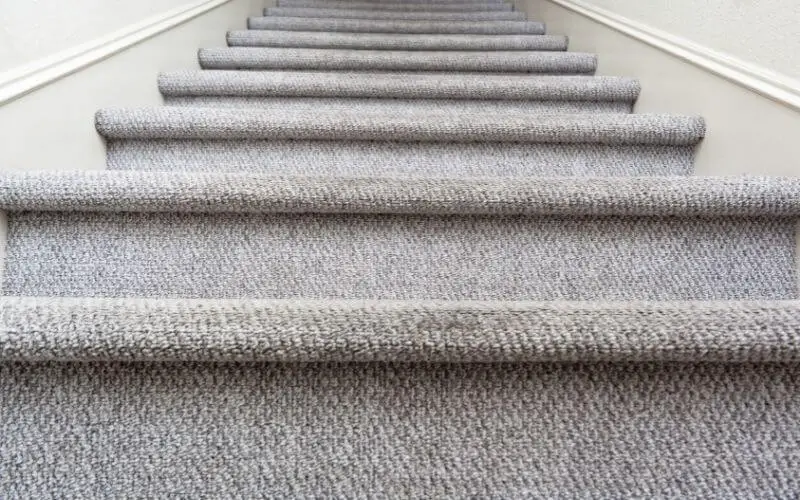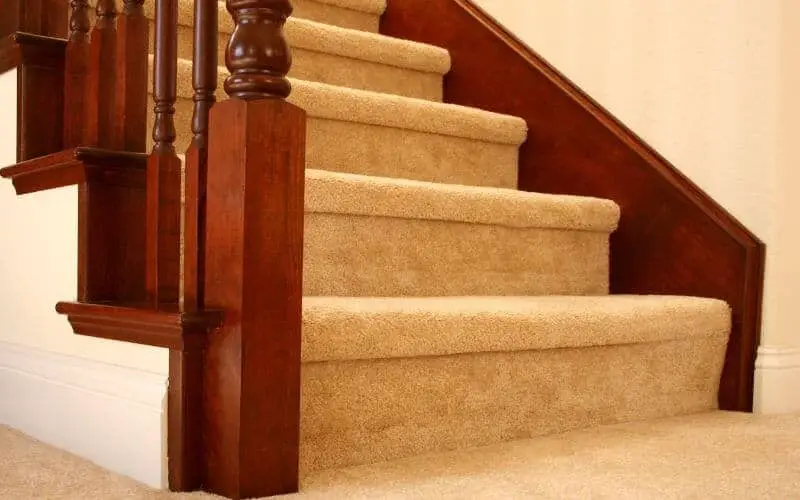Many homeowners cover their stairs with carpet to make walking on them more comfortable and to beautify the home. Most times these carpets get worn out, hence your question. How to redo carpeted stairs.
But unlike hardwood, carpet flooring is more susceptible to stains, wear, and overall damage; this means you may need to redo carpeted stairs earlier than you would a bare hardwood floor.
Redoing your carpeted stairs involves removing the old carpet, inspecting the stairs to make sure they are in good condition, cutting a new carpet to fit the size of the stairs and installing the carpet.
You can also decide to install new carpeting when remodeling your home; whatever the reason for the change, here are the steps involved in installing carpeted stairs.
Read: 10 best vacuum cleaner for stairs
How to Redo Carpeted Stairs
Table of Contents
Remove Old Carpeting
Before installing new carpeting on the stairs, you must take out the old carpet. To begin, find out how the carpet is attached to the stairs.
Carpet can be installed with nails or glue or a combination of both. It is important to know how your carpet is attached to the floor so you can determine the appropriate removal method.
Carpet removal can be incredibly easy or incredibly difficult, depending on how the carpet was attached to the stairs.
If the carpet was installed over a layer of padding, which is stapled down onto the wooden stair treads and held down with tack strips that run the perimeter of the stairs, uninstalling the carpet would be quite simple and straightforward.
You simply need to pull up the carpet away from the tack strips; the padding can also be pulled up in a similar fashion.
Some carpet installations, however, are glued down, and they are very difficult to remove. If the carpet is glued down, it will require significantly more effort to uninstall; you will need a floor scraper to help cut the carpet free of the glue.
To remove glued-down carpet, pry up the sides with a screwdriver or any similar tool until you get a better grip of the carpet, and when you do, pull it up with your hands.
Do this with caution and loosen the carpet piece by piece. After pulling up most of the carpet, use a putty knife to scrape away any carpet pieces and adhesive residue left on the stairs.
Stair Prep
After removing the old carpet, you do not just install any new material on the stairs; you need to prep the stairs and ensure they are in good condition.
Remove old staples and nails used to hold the padding as well as the tack strips on the floor; you can do this with a pair of pliers or with your cat’s claw pry bar.
Fix loose or rotten sections of the stairs and scrape off hardened glue residue on the floor. Some glues harden and petrify over time and can only be removed by sanding it down with a belt sander or palm sander until you reach the original base stair installation.
Choose A New Carpet
The stairs receive the most foot traffic in any home, so choosing a durable carpet that can withstand use and maintain its beauty is very crucial if you do not want to redo carpeted stairs earlier than you would like.
Choose high-quality carpeting for your stairs, opt for an affordable option but ensure it is very durable and can remain in good condition for a long time.
There are several types of suitable carpet types for covering the stairs. One factor to put into consideration is the pile density of the fabric.
The density indicates how close the threads of a carpet are to each other. Carpets with low pile density cannot be used on the stairs as they cannot withstand the weight of crushing feet. Carpets with a higher pile density are best suited for stairs.
You do not necessarily need a thick carpet as its thickness is not an indicator of durability. In fact, some of the most durable carpets are quite thin, and some thick ones are actually full of air.
Read: How often should carpet be replaced
Cut the Carpet To Size
You can decide to cover the stairs completely with carpet or install a stair runner. In full coverage, you cover the entire width of the stairs with carpet, but with a stair runner, you only cover the middle of the stairs with carpet.
Stair runners only cover the walking portion of the stairs, unlike full coverage where the stairs are covered completely with carpet, this provides extra sound insulation, but it is completely up to personal preferences.
When covering a staircase with carpet getting an accurate measurement is half the battle. Cover each stair with a piece of carpeting, and trim off any excess material so that it is flush against the wall or stair edge.
You can take enough buffer to avoid cutting off too much carpet as such a mistake cannot be corrected once it occurs.
You can also use paper to cut out a mold of the stairs measurement and use the molds to cut the exact size of carpeting with a putty knife.
Although you can use a putty knife to cut out the carpeting, a carpet cutter or specialized carpet knife will make the job easier.
Read: How to fix bleached carpet
Install Carpet On Stairs
With the carpet cut out to size, you can begin the installation. Use a caulk gun to apply adhesive to the steps of the stairs and place the carpet over it and press down to secure.
Start with the top of the stairs, and work your way down. To secure the carpet on the sides of the stairs, you can tap lightly with a rubber mallet.
You can also use staples or nails to reinforce the sides further as well. After covering the entire stairs with carpeting, allow the glue to dry for a couple of hours before resuming traffic on the staircase.
Read: How to fix squeaky stairs
Conclusion
Having covered steps on how to redo carpeted stairs, you will need to redo carpeted stairs if the carpeting becomes worn and damaged or if you simply want to give your home a new look.
Whatever the reason for the change, redoing carpeted stairs requires a number of steps, all of which were broken down in this article.

